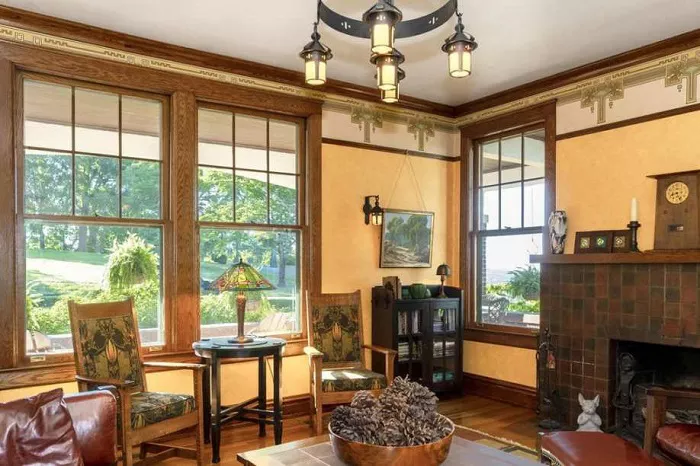Many of us face the dilemma of what to do with outdated or worn furniture—whether it’s a family heirloom, a beloved but deteriorating chair, or an item spotted at an estate sale. Instead of accepting these vintage pieces as they are, designers are showing how a little creativity and craftsmanship can transform old furniture into fresh, bespoke pieces.
Rayman Boozer, founder of Apartment 48, a New York-based interior design firm, explains that reupholstering existing furniture is a common practice in his work. “We take pieces that people already own and reupholster them, or we purchase vintage furniture and reupholster it to create truly unique items,” he says. Sometimes, the transformation can be subtle, and other times, a few changes can make the piece look entirely different.
Restoration: Preserving Charm While Refreshing Furniture
For furniture with historical value or sentimental attachment, restoration can be a more suitable approach than a full redesign. Dan Fink, a New York-based interior designer, emphasizes that the goal is often to maintain the integrity of the piece while restoring its former luster. For example, an antique armoire with a worn-paint finish might only require a cleaning to bring it back to life.
Restoration can also involve reconditioning wood, polishing metalwork, or replacing damaged components such as leather tops. “We’ll line drawers with materials like silk, suede, or wallpaper,” says Fink, “suddenly, the piece looks much more refined.”
Fabric Replacement: A Simple Yet Powerful Update
One of the most effective ways to change the appearance of upholstered furniture is by replacing its fabric. Designers often choose new fabrics that maintain the original spirit of the piece but make it more suitable for the current setting. Fink, for example, chose a light gray fabric to reupholster a modern sofa designed by architect Jorge Zalszupin, highlighting its distinctive wood frame.
Alternatively, designers may opt for bold new fabrics to make a statement. Boozer reupholstered an unloved settee in an African-inspired fabric he designed, featuring vibrant waves of red, orange, blue, and teal. The result was so striking that the piece was almost unrecognizable.
Additionally, changes to cushioning, such as altering the firmness or adding new tufting, can further refine the look and comfort of upholstered furniture. “It’s really affordable and makes the piece feel more custom,” says Emma Kemper, founder of Emma Beryl Interiors.
Tweaking the Shape: Subtle Modifications for a Modern Look
Reupholstering provides an opportunity for more drastic changes in shape. Designers may alter the back of a chair, shorten or extend arms, or adjust the height of a piece by modifying its legs. Rachael Rosenblum, founder of Double R Design, frequently makes such alterations to give old furniture a more contemporary appeal.
In one example, she streamlined keyhole-shaped arms on a sofa to give it a modern silhouette. Rosenblum also made over a secretary cabinet by replacing traditional wood panels with contemporary wave-shaped designs. “They’re pieces that would have been discarded, but now they’re beautiful,” she says.
Changing Wood Finishes: A Fresh Look for Old Furniture
Wood furniture can also be refreshed with a new finish. Scratched or damaged wood can be stripped and restained, or the piece can be treated with wax for a more natural, yet protective, finish. For those looking to add an even bolder change, painting wood furniture is an option.
For example, the interior design firm Carrier and Company Interiors painted an antique Chippendale chair white to better suit a modern room. The piece, once dark and dreary, was transformed into something sleek and sculptural. Patrick Mele, a designer from Greenwich, Conn., frequently uses paint to update antiques, such as giving a traditional gilt mirror a matte black finish for a minimalist yet dramatic effect.
Finishing Touches: Trimming for Added Style
After larger updates, it’s the small details that truly elevate a piece. Rosenblum suggests using decorative trims, such as piping, nailhead details, or fringe, to enhance the look of reupholstered furniture. These finishing touches can help customize a piece without making major structural changes.
For storage furniture like cabinets and desks, swapping out hardware can also make a significant difference. “Replacing wood pulls with sculptural brass pulls can completely change the look of a piece,” she adds.
Repurposing Furniture: Finding New Uses for Old Items
Sometimes, the best way to breathe new life into a vintage piece is to change its function. Fink frequently repurposes furniture for new uses; for instance, he once turned a restored French desk into a nightstand. Similarly, folding screens can be framed and used as large-scale artwork, adding character to a room in an entirely new way.
Mele has even reimagined garden urns as lamps by adding wiring and shades, transforming a classic outdoor piece into an indoor lighting feature.
New Furniture, Customized: Creating Personalized Pieces from Scratch
If the perfect vintage piece can’t be found, there’s no reason to settle. Designers like Kemper often use the same customization techniques on new furniture. “I reupholstered chairs from West Elm in a Paul Smith fabric,” she recalls, noting that the result made the chairs feel more high-end and perfectly suited to the room.
By combining restoration, customization, and creative thinking, designers are proving that vintage furniture can be reimagined in countless ways, making it relevant for modern spaces while preserving its unique charm.

